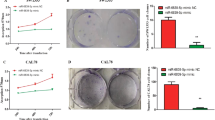Abstract
Purpose
Chondrosarcoma is a soft tissue sarcoma with a poor prognosis that is unresponsive to conventional chemotherapy. The regulatory mechanisms for the rapid proliferation of chondrosarcoma cells and the particular aggressiveness of this sarcoma remain poorly understood. In this study, we investigate the effect of epigallocatechin-3-gallate (EGCG) on growth and apoptosis of chondrosarcoma cells.
Methods
The chondrosarcoma cell lines, SW1353 and CRL-7891, were cultured with and without EGCG. The MTT assay was used to test the cytotoxicity of EGCG. Flow cytometry and DAPI staining were used to observe cell apoptosis caused by EGCG. To explore the effect of EGCG on the Indian Hedgehog signaling pathway and apoptosis-related proteins, RT-PCR and Western blotting were used to detect the expression of PTCH and Gli-1 in the Indian Hedgehog signaling pathway. Meanwhile, expression of Bcl-2, Bax, and caspase-3 were also evaluated by Western blot analysis.
Results
EGCG effectively inhibited cellular proliferation and induced apoptosis of SW1353 and CRL-7891. EGCG inhibited the human Indian Hedgehog pathway, down-regulated PTCH and Gli-1 levels, and induced apoptosis as confirmed by DAPI staining followed by flow cytometry. Protein expression levels of caspase-3 were unchanged in response to EGCG treatment in chondrosarcoma cells; however, the expression levels of Bcl-2 were significantly decreased and the levels of Bax were significantly increased.
Conclusions
Our findings demonstrate that EGCG is effective for growth inhibition of a chondrosarcoma cell lines in vitro, and suggest that EGCG may be a new therapeutic option for patients with chondrosarcoma.





Similar content being viewed by others
References
Adams JM, Cory S (1998) The Bcl-2 protein family: arbiters of cell survival. Science 281:1322–1326
Benoist-Lasselin C, De Margerie E, Gibbs L et al (2006) Defective chondrocyte proliferation and differentiation in osteochondromas of MHE patients. Bone 39:17–26. doi:10.1016/j.bone.2005.12.003
Damron TA, Ward WG, Stewart A et al (2007) Osteosarcoma, chondrosarcoma, and Ewing’s sarcoma: National Cancer Data Base Report. Clin Orthop Relat Res 459:40–47. doi:10.1097/BLO.0b013e318059b8c9
Fiorenza F, Abudu A, Grimer RJ et al (2002) Risk factors for survival and local control in chondrosarcoma of bone. J Bone Joint Surg Br 84:93–99
Fujiki H (2005) Green tea: Health benefits as cancer preventive for humans. Chem Rec 5:119–132
Graham HN (1992) Green tea composition, consumption, and polyphenol chemistry. Prev Med 21:334–350
Hou Z, Lambert JD, Chin KV, Yang CS (2004) Effects of tea polyphenols on signal transduction pathways related to cancer chemoprevention. Mutat Res 555:3–19. doi:10.1016/j.mrfmmm.2004.06.040
Ingham PW, McMahon AP (2001) Hedgehog signaling in animal development: paradigms and principles. Genes Dev 15:3059–3087. doi:10.1101/gad.938601
Islam S, Islam N, Kermode T et al (2000) Involvement of caspase-3 in epigallocatechin-3-gallate-mediated apoptosis of human chondrosarcoma cells. Biochem Biophys Res Commun 21(270):793–797. doi:10.1006/bbrc.2000.2536
Katoh Y, Katoh M (2006) Hedgehog signaling pathway and gastrointestinal stem cell signaling network. Int J Mol Med 18:1019–1023
Kinzler KW, Bigner SH, Bigner DD et al (1981) Identification of an amplified highly expressed gene in a human glioma. Science 236:70–73
Kronenberg HM, Lee K, Lanske B et al (1997) Parathyroid hormone-related protein and Indian Hedgehog control the pace of cartilage differentiation. J Endocrinol 154:S39–S45
Lambert JD, Yang CS (2003) Mechanisms of cancer prevention by tea constituents. J Nutr 133:3262S–3267S
Lauth M, Toftgard R (2007) Non-canonical activation of GLI transcription factors: implications for targeted anti-cancer therapy. Cell Cycle 6:2458–2463
Lee FY, Mankin HJ, Fondren G et al (1999) Chondrosarcoma of bone: an assessment of outcome. J Bone Joint Surg Am 81:326–338
Lum L, Beachy PA (2004) The hedgehog response network: sensors, switches, and routers. Science 304:1755–1759
Machold R, Hayashi S, Rutlin M et al (2003) Sonic hedgehog is required for progenitor cell maintenance in telencephalic stem cell niches. Neuron 39:937–950
Merry DE, Korsmeyer SJ (1997) Bcl-2 gene family in the nervous system. Annu Rev Neurosci 20:245–267
Molinari M (2000) Cell cycle checkpoints and their inactivation in human cancer. Cell Prolif 33:261–274
Peng CL, Guo W, Ji T et al (2009) Sorafenib induces growth inhibition and apoptosis in human synovial sarcoma cells via inhibiting the RAF/MEK/ERK signaling pathway. Cancer Biol Ther 8:1729–1736
Riedel RF, Larrier N, Dodd L et al (2009) The clinical management of chondrosarcoma. Curr Treat Options Oncol 10:94–106
Ruiz i Altaba A, Sanchez P, Dahmane N et al (2002) Gli and hedgehog in cancer: tumours, embryos, and stem cells. Nat Rev Cancer 2:361–372
Shimizu M, Weinstein IB (2005) Modulation of signal transduction by tea catechins and related phytochemicals. Mutat Res 591:147–160. doi:10.1016/j.mrfmmm.2005.04.010
Tiet TD, Hopyan S, Nadesan P et al (2006) Constitutive Hedgehog signaling in chondrosarcoma up-regulates tumor cell proliferation. Am J Pathol 168:321–330. doi:10.2353/ajpath.2006.050001
Yip KW, Reed JC (2008) Bcl-2 family proteins and cancer. Oncogene 27:6398–6406. doi:10.1038/onc.2008.307
Zhao JY, Chen G, Cao D et al (2010) Expression of Gli1 correlates with the transition of breast cancer cells to estrogen-independent growth. Breast Cancer Res Treat 119:39–51. doi:10.1007/s10549-009-0323-3
Acknowledgments
This work Supported by Peking University People’s Hospital Research and Development Funds (RDN2007-15).
Conflict of interest statement
We declare that we have no conflict of interest.
Author information
Authors and Affiliations
Corresponding author
Rights and permissions
About this article
Cite this article
Tang, GQ., Yan, TQ., Guo, W. et al. (−)-Epigallocatechin-3-gallate induces apoptosis and suppresses proliferation by inhibiting the human Indian Hedgehog pathway in human chondrosarcoma cells. J Cancer Res Clin Oncol 136, 1179–1185 (2010). https://doi.org/10.1007/s00432-010-0765-3
Received:
Accepted:
Published:
Issue Date:
DOI: https://doi.org/10.1007/s00432-010-0765-3




